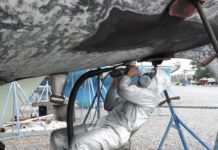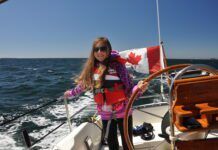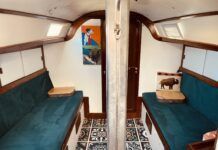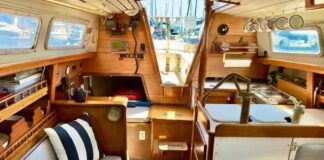Your beloved boat is no longer young. The laminate—the heart of her construction—may still be strong, but that protective gelcoat has gone chalky, and no amount of cleaning and waxing seems to bring it back. Her skin is losing its luster.
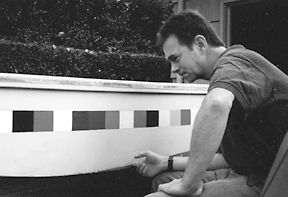
When you finally conclude that the topsides need painting, you’re not alone. There are hundreds of thousands of fiberglass boats that need the same treatment. Yet many sailors are reluctant to slap on the paint, first because, well… it’s a big move, and they won’t likely ever be returning to a new gelcoat, and second because they fear the paint won’t last, that it’ll need constant attention, and end up looking like the same chalky gelcoat in a fraction of the time.
The first reason for hesitation is justified—once you put on the paint, you’re not likely to remove it all and have a new gelcoat applied. The second reason for hesitation isn’t as valid as it used to be.
A Brief Paint Primer
People have been painting their surroundings and possessions ever since they decided that a cave was preferable to camping in the open with creatures who liked to eat them, but paint for something other than art really caught on in the 1700s. A hundred years later, there were paint factories all over the place. Canned paint was made with the now-verboten white lead, zinc oxide, potassium hydroxide, milk and resin. It was colored with anything handy. It was very heavy and hard to transport, so it tended to be locally manufactured by small companies. (That’s true of beer, too. Not so long ago you simply couldn’t buy a can or glass of Conglomerate.)
Boatyard prices for painting a boat’s topsides tend to be so high that they quote by the foot. That’s what the carpet merchants do, too. They used to sell carpet by the square yard; now it’s by the square foot. They probably think that the lower figure is less terrifying or that we can’t multiply.
Boatyard prices for painting your topsides vary considerably, depending mostly on how much prep work is needed. For an average boat, an Awlgrip job, maybe including a cove stripe and boot-top, goes for about $140 to $180 a foot. That makes the job on a 30′ boat a $4,200 to $5,400 budget item. You can paint your own boat. Right?
That’s what led to this Practical Sailor test of high-gloss enamel. All of the paint manufacturers agreed that the proposed test was a reasonable undertaking.
PS had readily available what you might call a well-seasoned 13′ Boston Whaler. Although the coming season will be her 35th in the water, she still has no name. Let’s call her… no, let’s not call her that.
As with any hard-working skiff used for both magazine projects and pleasure, Noname’s topsides were chalked, faded, gouged and scratched. It was long overdue for painting.
What Kinds of Paint?
It would be very difficult to apply to the skiff all the varieties of marine paint available, never mind the non-marine paints that might fit the bill.
It wouldn’t be fair, we thought, to compare the expensive and very technical two-part linear polyurethanes (like Awlgrip or Sterling), with one-part paint costing far less. But then we rethought it— why not put on some fancy paint, at least as a control? Let’s just see which paint has the best gloss, which covers best, and which lasts the longest.
We decided to work only with high-quality paint that can be applied with a brush. (Few boatowners want to deal with spray equipment, or have the expertise to use it correctly.)
For the test, PS collected 39 kinds of paint with 15 different labels. Although something in excess of 90% of topsides paint sold is white, it was decided to use red, white, and blue. The multiple-color decision was based on the long-standing (and possibly erroneous) belief that colored paints (especially red) fade very badly. Not to subvert the patriotic fervor, but there are also squares of brown and yellow (from Rust-Oleum) and green (from Ace Hardware).
Also the paint choice was based, with one exception, on what a boatowner might be offered by a chandlery or paint store as appropriate to paint the topsides of a boat.
This Practical Sailor paint test is an investment of both present and future time. For that reason, and also because readers might like to know if marine paints really are better than less expensive non-marine paints, the “Why Not” test was broadened to include a few off-the-shelf paints from hardware stores.
Our initial consultant was Jack Richardson, owner of what must be one of the largest independently owned hardware stores in the land—or at least in New England. When the project was explained to him, he said, “I’ll run the new Pitt-Tech against any of those marine paints.”
Pittsburgh Paints’ Pitt-Tech is described in its literature as a water-based “High Performance Acrylic Industrial Enamel.”
“If paint could be any better, Pittsburgh would make it,” Richardson said.
When asked how a water-based paint could have the initial gloss or durability of oil-based or chemical paints, he said, “Bring ’em on, baby. You’ll see after a few months of exposure.”

Pitt-Tech comes only in gallons; the price shown on the chart is simply a quarter of the gallon price ($38.99), the usual conversion used by paint makers.
The Andek Corporation’s Polagard AG, an industrial-grade two-part urethane, may be hard to find. Andek’s experimental paint expert, Paul Wingrove, offered to field telephone inquiries. (Wingrove also is working on an anti-fouling paint very heavily loaded with pepper; it’s an old approach, but Wingrove says Andek’s early tests look promising.)
PS intended to include also Sears’ best enamel. However, in one Sears store, the clerk said Sears doesn’t make a gloss enamel. In a second store, the man who responded when we asked for the department manager pointed at a huge Martha Stewart paint color display and said, “Take your choice.” There was no gloss enamel.
Included in the test is the widely known Rust-Oleum, a fish-oil based paint worked out around the turn of the century by a sea captain named Robert Ferguson, who noted that nothing rusted where fish oil was spilled on the deck of his ship. Ferguson carried the oar ashore in New Orleans, but the company is headquartered now in Vernon Hills, Illinois. It’s owned by a company called RPM, which, with 8,000 employees, is a fair-sized building materials manufacturer.
Another readily available brand included was Ace Hardware’s Gloss Enamel, described as “Our Very Best” oil-based polyurethane. A note on the can claims that it’s manufactured by Ace Hardware Corp., of Oak Brook, Illinois. All of the directions were followed except one: We did not use an Ace brush.
Taken all together, the collection represents roughly four kinds of paint—water-soluble latex coatings (also known as acrylics), time-tested alkyds (synthetic resins combined with oil), one-part urethanes and two-part urethanes. Within these categories, there are many variations used by the 700 US paint manufacturers who each year sell $16 billion worth of paint.
It would be easy to lapse into a discussion of the very complicated nature of modern paint. Suffice to say that the basic type of paint is identified on the accompanying chart.
All we want to know is how well they work on the boat.
How Was It Applied?
The Whaler was thoroughly scrubbed with strong soap and Clorox, and rinsed repeatedly. The entire topsides were sanded with 80-grit paper on an orbital sanding machine, washed and rinsed again, and moved inside, where it was allowed to dry for three days.
Then, along each side of the Whaler, a 3″ horizontal strip was scribed, 3″ down from the rail. (If you seek anything even close to perfection, the surface must be carefully prepared before painting; this usually is, as we’ve learned from painting two or three of PS’s test boats, far more work than applying the paint. That preparation—filling, patching and almost endless sanding—is outside the confines of this paint test.)
The topsides, other than what we slipped into calling “The Bracelet,” were painted with a good marine enamel.
The Bracelet was wiped clean again and divided into 39 squares, port and starboard, for the 39 kinds of paint. The “squares” actually are 3″ x 3-1/4″.
A description of the taping and numbering necessary to paint 78 adjoining squares would be, Dear Reader, hardly worth your subscription dollar. The experience, however, is one not worth repeating oftener than once per millennium.
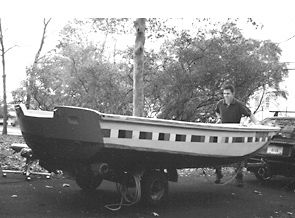
New brushes were used for every kind and color of paint. The squares were coated as heavily as possible, short of sagging, to give each paint ample opportunity to cover in one coat. (The paint industry usually uses one- or two-coat samples for testing; multiple coats merely prolong the test.)
Notes were made of each paint’s viscosity, which the industry describes as “the property to resist relative movement within itself.” Translated, that means how drippy is it and how well does it stay put. On the chart, that property is in a column headed “Handling.”
After all the extensive taping, painting, drying, retaping, etc., each square was carefully examined for “one-coat” coverage, meaning, “Is it good enough not to need a second coat?”
Finally, using a photographic light meter and a well-focused beam of light, the gloss of each surface was measured twice, on the duplicate strips on each side of the skiff.
Kick-Off Conclusions
Except for paints that covered so poorly that a second coat would be required to get a result in which you could take some pride, all of these paints look very nice. No one would be unhappy with their appearance.
However, what is sought initially is the very best combination of qualities, in the hope that the best paint might also be the most durable and best retain its gloss.
The initial four-step rankings (excellent, good, fair and poor) were used to convert the findings made of Handling (viscosity), Coverage (one-coat) and Gloss to numbers, which were averaged and ranged to fit the same four-step scale.
It complicates things somewhat, but it must be noted that within a given kind of paint, different colors sometimes put up different showings. This might be of interest to boatowners trying to decide on a color. The eight coatings that earned “excellent” ratings in this test were, with a couple of exceptions, expensive two-part coatings. They are Interlux’s Interthane Plus in red and white, and Epifanes’ Poly-Urethane in all three colors. (Two-part paints are more difficult to apply and reveal more imperfections in the surface. They’re best done with a crew of two or three people. If you can find helpers, use one person to mix and thin the paint, supply brushes, rags, etc. A second rolls the paint on the hull and has time to check for sags. The third carefully feathers and “tips off” the paint.)
The other two paints that earned excellent ratings are premium one-part enamels with fancy additives. They are Interlux’s relatively new Toplac in red or white, and Epifanes’ Mono-Urethane. Only one color, blue, was tested in Epifanes’ Mono-Urethane, and it happened to be the only blue that made the excellent rank.
Because the chart contains the detail, the 19 paints rated Good, the 7 rated Fair, and the 5 rated Poor will not be reiterated here. However, it should be noted that the three “non-marine” paints—Rust-Oleum, Pitt-Tech and Polagard—rated “Good,” outranking a lot of marine paint, in all three colors. How they last will be of great interest.
This initial test can be of value to someone about to paint right now. Considering how much work is involved in preparation and the actual painting, we doubt that cost is much of a factor with most boat owners.
So, the real test—pitting these coatings against their relentless enemies—sun, salt water, abrasion, scrapes, aging, and general editorial abuse—begins now.
Contacts— Andek Corp., 850 Glen Ave., Moorestown, NJ 08057, 856/786-6900. Epifanes North America, 70 Water St., Thomaston, ME 04861, 800/269-0961, www.epifanes.com/. Interlux, 2270 Morris Ave., Union, NJ 07083, 800/468-7589. Pittsburgh, PPG Industries, Inc., One PPG Place, Pittsburgh, PA 15272, 800/441-9695, www.yachtpaint.com/usa/. Rust-Oleum, 11 Hawthorn Parkway, Vernon Hills, IL 60061, 800/553-8444, www.rustoleum.com/. Pettit & Kop-Coat, 36 Pine St., Rockaway, NJ 07866, 800/221-4466, www.pettitpaint.com/. U.S. Paint, 831 S. 21 St., St. Louis, MO 63103, 314/621-0525. West Marine, 500 Westridge Dr., Watsonville, CA 95077-0507, 800/262-8464, www.westmarine.com/.
Also With This Article
Click here to view “Topside Paints: Initial Ratings.”


















